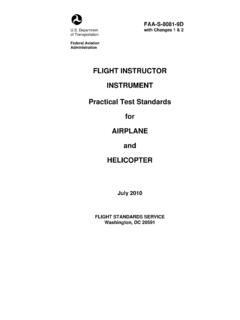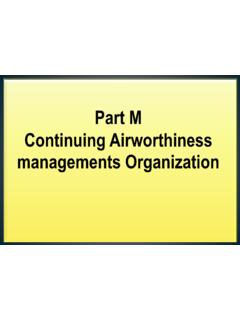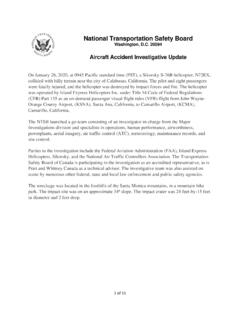Transcription of Unmanned Aircraft Systems (UAS) Reports - NASA
1 ASRS Database Report Set Unmanned Aircraft Systems (UAS) Reports Report Set Description .. Reports involving Unmanned Aircraft Systems (UAS). events reported by operators of manned or Unmanned Aircraft . Update Number ..14. Date of Update ..November 17, 2021. Number of Records in Report Set ..50. Records within this Report Set have been screened to assure their relevance to the topic. National Aeronautics and Space Administration Ames Research Center Moffett Field, CA 94035-1000. TH: 262-7. MEMORANDUM FOR: Recipients of Aviation Safety Reporting System Data SUBJECT: Data Derived from ASRS Reports The attached material is furnished pursuant to a request for data from the NASA Aviation Safety Reporting System (ASRS). Recipients of this material are reminded when evaluating these data of the following points. ASRS Reports are submitted voluntarily. The existence in the ASRS database of Reports concerning a specific topic cannot, therefore, be used to infer the prevalence of that problem within the National Airspace System.
2 Information contained in Reports submitted to ASRS may be amplified by further contact with the individual who submitted them, but the information provided by the reporter is not investigated further. Such information represents the perspective of the specific individual who is describing their experience and perception of a safety related event. After preliminary processing, all ASRS Reports are de-identified and the identity of the individual who submitted the report is permanently eliminated. All ASRS report processing Systems are designed to protect identifying information submitted by reporters; including names, company affiliations, and specific times of incident occurrence. After a report has been de-identified, any verification of information submitted to ASRS would be limited. The National Aeronautics and Space Administration and its ASRS current contractor, Booz Allen Hamilton, specifically disclaim any responsibility for any interpretation which may be made by others of any material or data furnished by NASA in response to queries of the ASRS.
3 Database and related materials. Becky L. Hooey, Director NASA Aviation Safety Reporting System CAVEAT REGARDING USE OF ASRS DATA. Certain caveats apply to the use of ASRS data. All ASRS Reports are voluntarily submitted, and thus cannot be considered a measured random sample of the full population of like events. For example, we receive several thousand altitude deviation Reports each year. This number may comprise over half of all the altitude deviations that occur, or it may be just a small fraction of total occurrences. Moreover, not all pilots, controllers, mechanics, flight attendants, dispatchers or other participants in the aviation system are equally aware of the ASRS or may be equally willing to report. Thus, the data can reflect reporting biases. These biases, which are not fully known or measurable, may influence ASRS information. A safety problem such as near midair collisions (NMACs) may appear to be more highly concentrated in area A than area B simply because the airmen who operate in area A are more aware of the ASRS program and more inclined to report should an NMAC occur.
4 Any type of subjective, voluntary reporting will have these limitations related to quantitative statistical analysis. One thing that can be known from ASRS data is that the number of Reports received concerning specific event types represents the lower measure of the true number of such events that are occurring. For example, if ASRS receives 881 Reports of track deviations in 2010 (this number is purely hypothetical), then it can be known with some certainty that at least 881 such events have occurred in 2010. With these statistical limitations in mind, we believe that the real power of ASRS data is the qualitative information contained in report narratives. The pilots, controllers, and others who report tell us about aviation safety incidents and situations in detail . explaining what happened, and more importantly, why it happened. Using report narratives effectively requires an extra measure of study, but the knowledge derived is well worth the added effort. Report Synopses ACN: 1824677 (1 of 50).
5 Synopsis UAS pilot flew in Class D airspace without authorization. ACN: 1824343 (2 of 50). Synopsis UAS had a lost link occur during flight. Pilot regained link with UAS and used manual control to recover the UAS. ACN: 1823392 (3 of 50). Synopsis UAS flight crew operating at an uncontrolled airport had a near miss with a helicopter . ACN: 1821768 (4 of 50). Synopsis Recreational/hobby UAS pilot checked and used an app created by the manufacturer of the UAS being flown. The app has several no-fly areas listed but did not list the Class D. airspace of a nearby airport. The UAS was flown within the Class D airspace without proper authorization. ACN: 1821478 (5 of 50). Synopsis Multi person UAS flight crew was conducting a crew swap while UAS was flying near weather and building clouds. After crew swap the UAS was flown inadvertently into icing conditions and was able to exit. ACN: 1820785 (6 of 50). Synopsis Hobbyist UAS pilot was distracted by an animal while flying. The UAS flew into an area with high winds and the UAS pilot was unable to maintain control of the UAS which crashed a short time later.
6 ACN: 1819468 (7 of 50). Synopsis Air taxi flight crew noticed a UAS pass 2 feet over the wing during descent and notified ATC. ACN: 1818330 (8 of 50). Synopsis Air carrier flight crew climbing through 13,000 feet reported a near miss with a UAS. approximately 200 feet below the Aircraft . ATC was notified. ACN: 1817997 (9 of 50). Synopsis UAS encountered wind shear and was unable to maintain altitude. Flight crew was able to regain control of the UAS and return to previous altitude. ACN: 1817312 (10 of 50). Synopsis Passenger on an air carrier flight was looking through the window while the Aircraft was on approach. The passenger saw a large UAS approximately 150 feet away. The UAS began to climb and the passenger was unable to inform the flight crew. ACN: 1817230 (11 of 50). Synopsis Air carrier flight crew established on an ILS approach noticed they flew past a UAS on the left side of their Aircraft . Crew notified ATC. ACN: 1816745 (12 of 50). Synopsis Part 107 pilot was conducting a recreational proficiency flight.
7 The flight occurred during the hours of dusk and winds were starting to increase. The pilot noticed difficulty controlling the UAS near 400 feet therefore descended to a lower altitude to regain control of the UAS. ACN: 1816005 (13 of 50). Synopsis Air carrier flight crew descending via a STAR procedure experienced a near miss with a UAS passing approximately 10-30 feet below. Flight crew notified ATC. ACN: 1815943 (14 of 50). Synopsis helicopter pilot on final approach into Class D airport took evasive action to avoid a collision with a UAS. The pilot notified ATC. ACN: 1815850 (15 of 50). Synopsis Air carrier flight crew was descending into a Class B airport on a STAR. At approximately 6,000 feet they had a near miss with a UAS and advised ATC. ACN: 1815722 (16 of 50). Synopsis Part 107 UAS pilot conducted an inspection over private property. After the flight, ground staff learned the flight took place within Class D airspace. ACN: 1814773 (17 of 50). Synopsis Part 107 pilot was flying UAS when a lost link occurred.
8 Pilot was unable to reconnect to the UAS and it was lost/unrecoverable. ACN: 1814090 (18 of 50). Synopsis General aviation pilot struck a UAS while on approach. After landing and during inspection of the Aircraft the pilot found damage to the wing of the Aircraft . ACN: 1813818 (19 of 50). Synopsis UAS pilot was unable to maintain control of the UAS due to equipment malfunctions and gusty winds. The UAS crashed in an area of dry grass where the Pilot was able to recover the UAS with exception of the battery. ACN: 1813541 (20 of 50). Synopsis Part 107 UAS pilot used the LAANC system to request authorization for a flight within controlled airspace. The request was not approved and the pilot continued with the flight in controlled airspace. ACN: 1813523 (21 of 50). Synopsis Pilot reported a near miss with a UAS. ACN: 1813302 (22 of 50). Synopsis Air carrier flight crew was given a traffic alert from air traffic control about a UAS near the final approach path. At 3,500 feet and near the final approach fix the flight crew saw a UAS pass 50 feet away.
9 Aircraft landed without incident. ACN: 1812712 (23 of 50). Synopsis A VFR pilot in cruise flight at 15,500 feet noticed a small UAS about 1000 feet below them flying in the opposite direction. ACN: 1812556 (24 of 50). Synopsis Air carrier flight crew was on an IFR flight, cruising at 5,000 feet. The pilot received a Traffic Alert and noticed an object directly ahead of them. Without time to react and after passing the object the pilot noticed they had a near miss with a multi-rotor UAS. ACN: 1811687 (25 of 50). Synopsis Air carrier flight crew was on a final for an ILS approach when they came within 50F ft. of a large sized UAS. Crew notified ATC and landed safely. ACN: 1811646 (26 of 50). Synopsis A fixed wing pilot had a near miss with a UAS during cruise flight. ACN: 1811318 (27 of 50). Synopsis Pilot noticed fatigue cracks in post flight inspection of UAS. ACN: 1811317 (28 of 50). Synopsis Pilot noticed the battery on the UAS became dislodged during the flight. ACN: 1811005 (29 of 50).
10 Synopsis An air carrier flight crew on visual approach to a Class B airport observed a drone pass along the Aircraft at 5,000 feet. Crew notified ATC. ACN: 1810373 (30 of 50). Synopsis Part 107 crew had a lost link with the UAS. After attempting a return to home (RTH). function the Crew was unable to regain control of the UAS which crashed shortly after. ACN: 1809433 (31 of 50). Synopsis An eyewitness saw two UAS flying within a Special Air Traffic Rule (SFAR) area close to numerous operating fixed wing and rotor wing Aircraft . ACN: 1809244 (32 of 50). Synopsis An air carrier flight crew was on final approach descending past 3,000 feet when they noticed a UAS above them and notified ATC. ACN: 1809236 (33 of 50). Synopsis Air carrier flight crew had a near miss with a UAS while on approach. ACN: 1809084 (34 of 50). Synopsis Air Carrier Captain reported a near miss with a UAS while on approach. ACN: 1808986 (35 of 50). Synopsis Recreational Drone Pilot reported inadvertently flying within Class B airspace from the parking lot of a stadium complex.






